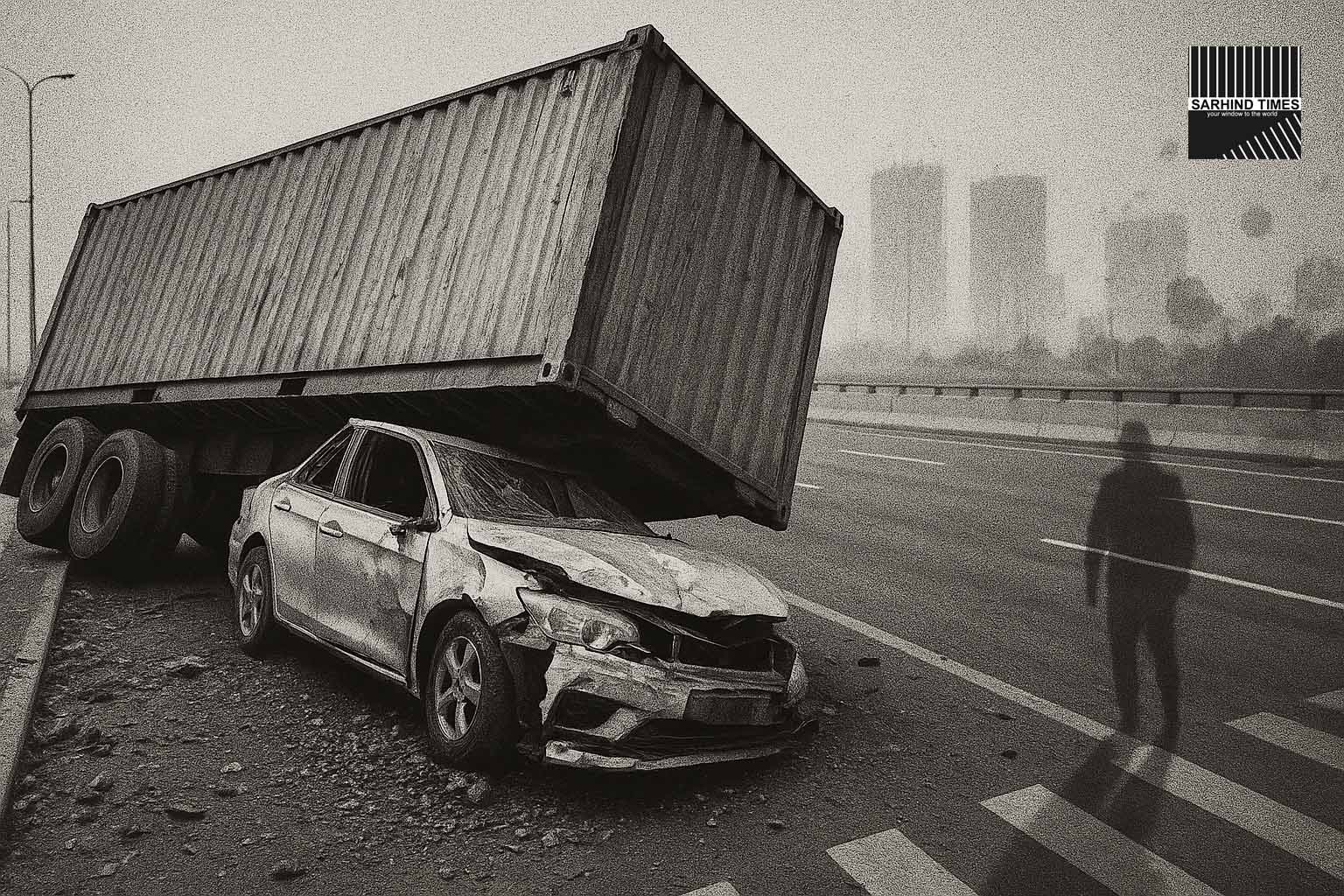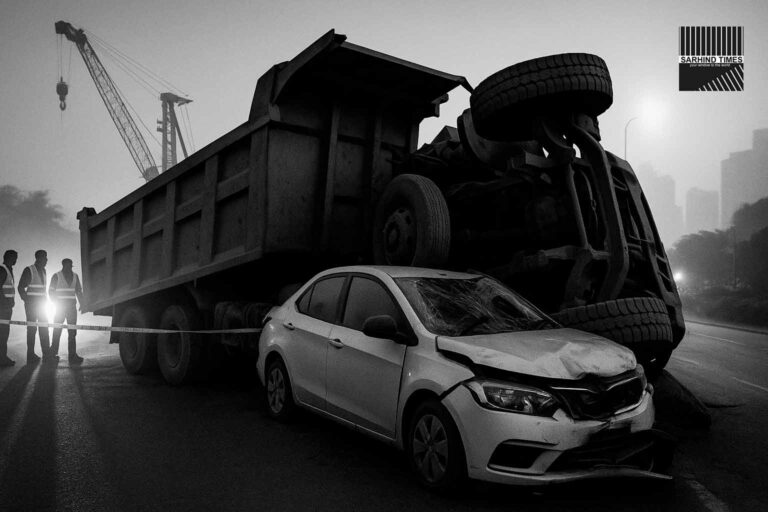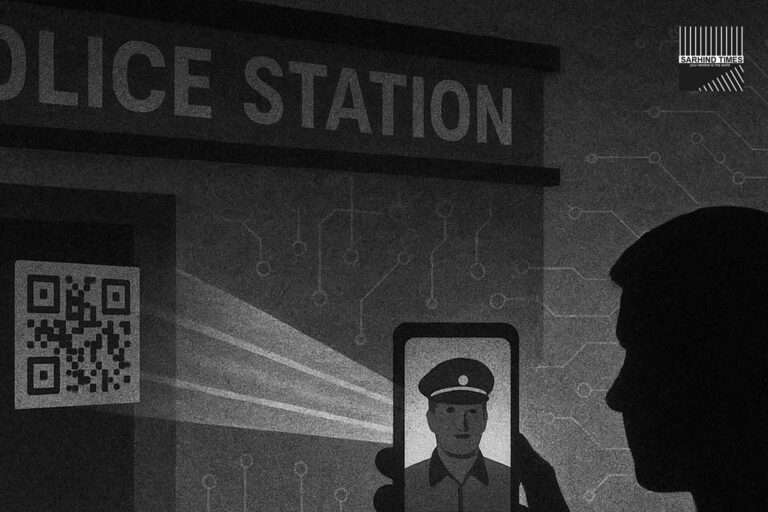Gurgaon, October 17, 2025 — In a grim reminder of the dangers lurking on NCR’s arteries, a gravel-laden trailer overturned onto a cab in Sector 50 near St Xavier’s, killing 27-year-old Nitish Kumar and injuring two others. The driver, who fled immediately after the crash, was arrested by Gurgaon Police the following day. Initial investigations point to overloading and overspeeding, though the trucker claims a technical fault triggered the roll.
The case has reignited public calls for stricter regulation of heavy vehicles in residential zones, highlighting how rapid urban expansion and construction traffic continue to threaten commuter safety. The crash is emblematic of the friction between infrastructure growth and road safety norms in India’s emerging cities.
Incident Breakdown: What Happened & Who Was Affected
Crash Scene & First Response
On the evening of October 16, the trailer, loaded with loose gravel, overturned onto a cab near the gate of St Xavier’s School in Sector 50. The cab’s roof was crushed, trapping occupants. One of them, Nitish Kumar, a Wipro security staffer, succumbed to injuries. The other two were rushed to hospital, stable but hurt.
Unverified eyewitness accounts suggest the trailer swerved before tipping, possibly to avoid a pothole. The driver, a 35-year-old, fled on foot, abandoning the vehicle. Locals flagged down police patrols soon after.
Arrest & Legal Charges
Gurgaon Police confirmed the arrest. The driver is booked under relevant Bharatiya Nyaya Sanhita (BNS) sections for culpable homicide not amounting to murder, grievous hurt, rash & negligent driving, and attempt to escape. Mechanical inspection of the trailer is underway, alongside CCTV footage review from nearby cameras.
Investigators are examining the trailer’s loading manifest (if any), braking system logs, tire condition, and driver’s logbook, if available.
Antecedents: Overloading, Speed & Technical Fault Claims
Overloaded trucks are a persistent menace on NCR roads, especially given the construction boom. Officials recount repeated violations—no overloading audits, lax weighbridge checks, especially during off-hours.
Police sources state the driver claimed a technical defect—possibly brake failure or axle malfunction—preceded the tipping. That claim is under forensic scrutiny. Yet, preliminary forensic indicators point to speed + load imbalance as the likelier trigger.
Urban Growth vs. Road Discipline: The Structural Tensions
Construction Traffic Infiltration
Gurgaon’s construction sites generate heavy traffic through residential corridors daily. Many trucks traverse feeder roads which were never designed for such loads. Sector roads like 50, 88, 90, 95 face daily stress.
Civic groups say that having no defined heavy-vehicle corridors forces frequent detours and misuse of residential streets, increasing crash risk.
Black Spots & Speed Zones
Citizen groups have long pointed to black spots near schools, colonies, and sport complexes, where fatal accidents often occur. Residents want speed-calming measures: speed breakers, rumble strips, signage, vehicle route restrictions during school hours.
The trailer crash adds urgency: heavy vehicles accessing tight zones need regulated schedules and oversight.
Legal & Policy Dimensions
Enforcement & Oversight
Despite speed cameras and weighbridges in NCR, enforcement is often weak or outsourced. Many trailers bypass checks after working hours or via alternative routes.
Until now, penalties have been fines or suspensions—rarely detentions. Public demand is calling for more severe action: impounding, driver licensing sanctions, operator accountability.
Regulatory Gaps
Transport and municipal authorities often function in silos. Coordination gaps between Haryana Transport, Gurgaon Traffic Police, Municipal Corporation, and Construction Authorities complicate enforcement.
No mandated schedule limits heavy vehicles in residential zones during peak hours. Licensing for construction contractors seldom mandates route discipline.
Human Angle: Victim, Family, and Community Impact
Nitish Kumar, the deceased, was a young security professional supporting a small family. His death reverberated through his community and workplace. The injured — one a female occupant — faced shock and trauma. Local residents say such crashes are no longer anomalies—they are an existential hazard.
In interviews, some citizens recounted blocked pavements, speeding trailers, and near-miss incidents daily. Parents of children walking to school worry: what price safety when trucks rumble through their zones?
Comparative Snapshots: NCR Crash Trends
Data from NCR suggests a growing trend of heavy-vehicle accidents in peripheral sectors of Gurgaon, Faridabad, Noida and Ghaziabad. Construction corridor accidents have become frequent during dawn and dusk hours.
A 2023 study by a Delhi think tank found that 30% of fatal crashes in NCR involved trucks or trailers, often due to overloading or mechanical failure. Local governments across NCR are under pressure to adopt Unified Truck Route Plans and Night-time construction cut-offs.
What Needs to Change: Key Reforms
- Strict access controls: Heavy vehicles barred from residential sectors between 7 am–10 pm, except via approved routes
- Mandatory weighbridge checkpoints on ingress/egress points near construction zones
- GPS + telematics enforcement: Live monitoring of trailer load, speed, braking patterns
- Black spot audits and redesign: Engineering fixes such as median separators, rumble strips, signage, speed breakers
- Licensing accountability: Drivers and operators penalized, repeat offenders banned
- Coordination cells: Inter-agency task forces among transport, traffic, civic, and police
- Public disclosure & hotlines: Citizens can flag overweight vehicles or traffic violations
Such reforms, though resource- and coordination-intensive, can shift the safety paradigm.
Voices & Reactions
“I saw the trailer swerve, felt a thud, and the car roof collapsed,” said one eyewitness.
“These roads were never meant for constant construction traffic. We warn authorities repeatedly, but action is slow,” said a Sector 50 resident.
A police official, on condition of anonymity, noted: “This one will be a test case—if we treat it weakly, nothing will change.”
Transport safety expert Dr. Meera Bansal commented:
“Rapid city growth demands a safety infrastructure catch-up—designated heavy-vehicle corridors, predictable schedules, and stiff enforcement are not optional—they are necessary.”
What to Monitor Next
- The forensic report: brake, axle, load and speed analysis
- How many more trucks or trailers are impounded in the coming week
- Whether route restrictions or advisories are issued for construction traffic
- Community push: black spot mapping, citizen complaint redressal
- Policy response: Haryana transport / municipal traffic reforms
- Crash frequency trends: will similar incidents spike?
Conclusion
The trailer-overturn tragedy in Sector 50 is a stark reminder that India’s urban growth cannot outpace safety frameworks. One death, two injured—those are human lives, not statistics.
Gurgaon faces a crossroad: either accept heavy-vehicle risk in service of growth, or embed road discipline into its fabric. The crash should be a catalyst: for interdepartmental coordination, design rethinking, stricter enforcement, and citizen vigilance.
If not, this will be one among many. But if we seize the moment, it may be the pivot where Gurgaon transitions from chaotic expansion to safer evolution.
#Gurgaon #RoadSafety #NCR #Traffic #UrbanPlanning #LawAndOrder #HeavyVehicles #AccidentPrevention

























+ There are no comments
Add yours